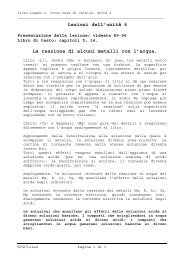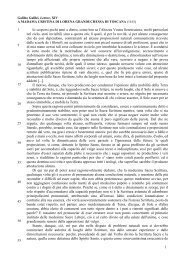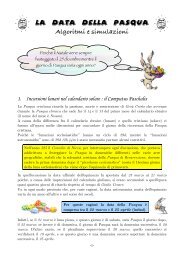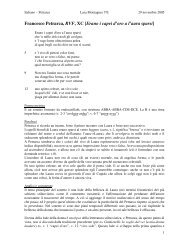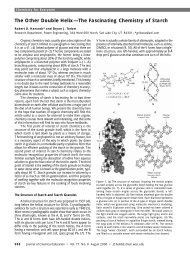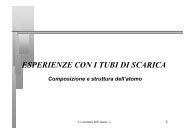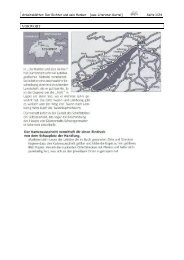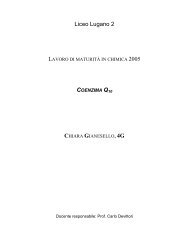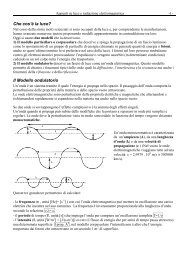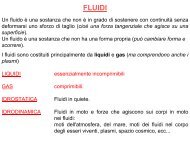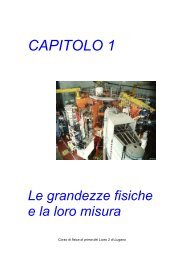Supercritical impregnation of polymers - ZyXEL NSA210
Supercritical impregnation of polymers - ZyXEL NSA210
Supercritical impregnation of polymers - ZyXEL NSA210
Create successful ePaper yourself
Turn your PDF publications into a flip-book with our unique Google optimized e-Paper software.
Current Opinion in Solid State and Materials Science 7 (2003) 399–405<br />
<strong>Supercritical</strong> <strong>impregnation</strong> <strong>of</strong> <strong>polymers</strong><br />
Ireneo Kikic * , Febe Vecchione<br />
Chemical, Environmental and Raw Materials Engineering Department (DICAMP), University <strong>of</strong> Trieste, P.le Europa, 1, Trieste 34127, Italy<br />
Received 11 August 2003; received in revised form 4 September 2003; accepted 4 September 2003<br />
Abstract<br />
The interest in the supercritical fluid <strong>impregnation</strong> <strong>of</strong> polymeric materials stems from the opportunity to utilize high diffusivity,<br />
low surface tension and the ease <strong>of</strong> solvent recovery for the preparation <strong>of</strong> new polymeric materials. This term includes a wide range<br />
<strong>of</strong> applications <strong>of</strong> the supercritical <strong>impregnation</strong> process that will be discussed in this review: preparation <strong>of</strong> drug delivery systems<br />
via <strong>impregnation</strong> <strong>of</strong> an active principle in a polymer matrix, dye and organic metallic complexes <strong>impregnation</strong> and polymer blends<br />
preparation via <strong>impregnation</strong> <strong>of</strong> a monomer and an initiator in a swollen polymer matrix.<br />
Ó 2003 Elsevier Ltd. All rights reserved.<br />
1. Introduction<br />
Recently, supercritical fluids have been applied for<br />
polymerization, swelling, <strong>impregnation</strong>, fractionation,<br />
purification and formation <strong>of</strong> powdered <strong>polymers</strong>. One<br />
<strong>of</strong> the important effects on <strong>polymers</strong> is the plasticizing<br />
effect <strong>of</strong> CO 2 with a decrease <strong>of</strong> the glass transition<br />
temperature [1].<br />
<strong>Supercritical</strong> carbon dioxide (SCCO 2 ) can reversibly<br />
swell glassy and rubbery <strong>polymers</strong> and reduce the viscosity<br />
<strong>of</strong> the polymer melts by up to an order <strong>of</strong> magnitude<br />
[2].<br />
The <strong>impregnation</strong> process is feasible when the active<br />
substance (the solute) is soluble in the supercritical<br />
fluid, the polymer is swollen by the supercritical solution<br />
and the partition coefficient is favourable enough to<br />
allow the matrix to be charged with enough solute.<br />
The fact that a high product purity is obtained (free<br />
<strong>of</strong> residual solvent) is important when considering the<br />
production <strong>of</strong> foods and pharmaceuticals, where it reduces<br />
the costs incurred in the removal <strong>of</strong> residual solvent<br />
[3].<br />
The interactions within the SCCO 2 -assisted <strong>impregnation</strong><br />
system are reported in Fig. 1.<br />
Impregnation processes can be classified on the base<br />
<strong>of</strong> the following criteria:<br />
* Corresponding author. Tel.: +39-40-5583433; fax: +39-40-569823.<br />
E-mail address: ireneok@dicamp.units.it (I. Kikic).<br />
1. The solubility <strong>of</strong> the solute in the supercritical fluid.<br />
2. The solute modification inside the polymer matrix.<br />
Referring to the first one <strong>of</strong> these, it is important to<br />
distinguish between two different mechanisms; the first<br />
involves deposition <strong>of</strong> a substance soluble in a supercritical<br />
fluid into the polymer matrix upon depressurisation.<br />
In this case, even a solute that has low affinity for<br />
the polymer matrix can be trapped within a polymer<br />
matrix, but in this case we have the formation <strong>of</strong> recrystallized<br />
substances within the polymer matrix without<br />
a molecularly dispersed formulation. A different<br />
mechanism utilizes the high partition coefficient <strong>of</strong> solute<br />
between the polymer and fluid phases due to a high<br />
affinity <strong>of</strong> the solute for the polymer matrices. This<br />
mechanism has tremendous potential for the supercritical<br />
fluid <strong>impregnation</strong> <strong>of</strong> drug molecules into <strong>polymers</strong><br />
[4].<br />
Referring to the second criterion, it is possible to<br />
distinguish between:<br />
• Solutes which are not modified in the polymer matrix:<br />
drugs,<br />
dyes (both for polymer and textile).<br />
• Solutes which undergo a modification during the <strong>impregnation</strong><br />
process:<br />
organometallic complexes for the <strong>impregnation</strong> <strong>of</strong><br />
<strong>polymers</strong> (90% <strong>of</strong> cases),<br />
monomers with initiator for polymer blends preparation.<br />
1359-0286/$ - see front matter Ó 2003 Elsevier Ltd. All rights reserved.<br />
doi:10.1016/j.cossms.2003.09.001
400 I. Kikic, F. Vecchione / Current Opinion in Solid State and Materials Science 7 (2003) 399–405<br />
dissolving<br />
SC CO 2<br />
1<br />
Additive<br />
3<br />
swelling<br />
4<br />
plasticizing<br />
Before presenting the different processes, the behaviour<br />
<strong>of</strong> the binary system (supercritical fluid–polymer)<br />
will be considered.<br />
2. <strong>Supercritical</strong> fluid–polymer interaction<br />
loading<br />
<strong>Supercritical</strong> fluids can interact not only with <strong>polymers</strong><br />
at temperatures higher than the s<strong>of</strong>tening point but<br />
also with <strong>polymers</strong> in the glassy state. Three concomitant<br />
effects must be considered: the dissolution <strong>of</strong> the<br />
SCF (polymer sorption), the swelling <strong>of</strong> the polymer<br />
matrix and the glass transition temperature (T g ) depression,<br />
simply called plasticization.<br />
The plasticization effect is an important feature: the<br />
sorbed gas acts as a kind <strong>of</strong> Ôlubricant’, making it easier<br />
for chain molecules to slip over one another, and thus<br />
causing polymer s<strong>of</strong>tening. The measured depression<br />
reaches values as high as 60 °C for poly(methyl methacrylate)<br />
and poly(styrene).<br />
Measurements <strong>of</strong> glass transition temperatures at<br />
high pressures can be only indirect; recently, a new<br />
method has been developed for measuring the glass<br />
transition temperature: it is based on a supercritical fluid<br />
chromatographic technique. In this case, using the supercritical<br />
fluid at a given pressure as mobile phase and<br />
the polymer under investigation as stationary phase, the<br />
retention volumes <strong>of</strong> various organic solutes are measured<br />
at different temperatures [5,6].<br />
Some attempts can be found in the literature to model<br />
both the sorption <strong>of</strong> a supercritical fluid in a glassy<br />
polymer and the glass transition temperature depression<br />
induced by supercritical fluids.<br />
Regarding the shift <strong>of</strong> the glass transition temperature,<br />
the most important contribution is due to Condo<br />
et al. [7]. In this approach the Gibbs Di Marzio criterion<br />
(at the glass transition the entropy <strong>of</strong> the system is zero)<br />
is used together with the Sanchez–Lacombe equation <strong>of</strong><br />
state. The possibility <strong>of</strong> the so-called retrograde vitrification<br />
is suggested: when the temperature is reduced at<br />
constant pressure, it is possible to observe a first liquid–<br />
glass transition followed by a second transition from the<br />
glass-back to the liquid-state.<br />
A detailed description <strong>of</strong> the model and a discussion<br />
on the effects <strong>of</strong> different parameters is reported in [6,8].<br />
2<br />
Polymer<br />
Substrate<br />
Fig. 1. Interactions between the SCCO 2 -assisted <strong>impregnation</strong> system.<br />
Another approach proposed originally by Wissinger<br />
and Paulaitis [9] introduces an additional variable (order<br />
parameter) that describes the thermodynamic state <strong>of</strong> a<br />
system. As the order parameter, the fraction <strong>of</strong> holes in<br />
the lattice and the number <strong>of</strong> nearest-neighbour contacts<br />
between polymer segments on the lattice sites are used.<br />
The NELF model, recently proposed by Doghieri and<br />
Sarti [10] uses as an order parameter the density <strong>of</strong> the<br />
swollen polymeric phase and the Sanchez–Lacombe<br />
equation <strong>of</strong> state for the evaluation <strong>of</strong> the chemical<br />
potential <strong>of</strong> the supercritical fluid in the gas phase (pure<br />
supercritical fluid) and in the polymeric phase. This<br />
approach can also be modified using a different equation<br />
<strong>of</strong> state for the gas phase, and does not require any binary<br />
interaction parameter. In this way, the sorption<br />
behaviour can be predicted from the swelling data alone.<br />
Since swelling measurements are, in general, more<br />
difficult to perform, it was recently [11] proposed to use<br />
the model as an empirical method to correlate and<br />
predict sorption data. Using one experimental sorption<br />
data point, and applying the NELF model, it is possible<br />
to predict the sorption at other pressures and temperatures.<br />
3. <strong>Supercritical</strong> <strong>impregnation</strong> processes<br />
3.1. Drugs <strong>impregnation</strong><br />
Controlled-release products have recently received<br />
considerable attention in the pharmaceutical industry<br />
since their use significantly reduces the problems connected<br />
with excessive dosages.<br />
In the preparation <strong>of</strong> controlled-release drugs, a liquid<br />
solvent swelling the polymer matrix and serving as a<br />
carrier for the drug component, is used. An alternative is<br />
to substitute the liquid organic solvent by a supercritical<br />
fluid with the advantage that the final product is completely<br />
free <strong>of</strong> any residual solvent contamination.<br />
Guney and Akgerman [12] investigated the <strong>impregnation</strong><br />
<strong>of</strong> a biodegradable polymer matrix, poly-dllactide-co-glycolide<br />
(PLGA), with 5-fluorouracil and<br />
b-estradiol, drugs that are used for chemotherapy and<br />
estrogen hormone therapy, respectively.<br />
The experimental set-up includes a saturation column<br />
packed with the drug, and an <strong>impregnation</strong> vessel in<br />
which the polymer is placed. Sorption experiments require<br />
the introduction <strong>of</strong> a drug-saturated CO 2 stream<br />
into the <strong>impregnation</strong> column. That is why the experiment<br />
consists <strong>of</strong> two sections: solubility measurement<br />
followed by <strong>impregnation</strong>. The apparatus is also<br />
equipped for a qualitative determination <strong>of</strong> polymer<br />
swelling.<br />
For b-estradiol at 35 °C and 207 bar, the impregnated<br />
amount (q ¼ mg drug/g PLGA) was 10.24 while at 55 °C<br />
and 207 bar, it arrives at 26.80.
I. Kikic, F. Vecchione / Current Opinion in Solid State and Materials Science 7 (2003) 399–405 401<br />
For 5-fluorouracil at 55 °C and 207 bar, the impregnated<br />
amount was very low (0.49).<br />
For these specific applications the drug loadings obtained<br />
are even higher than necessary since the therapeutical<br />
level for these products is much lower [12].<br />
Kazarian and Martirosyan [4] used ATR-IR spectroscopy<br />
to study the process <strong>of</strong> <strong>impregnation</strong> <strong>of</strong> ibupr<strong>of</strong>en<br />
into poly(vinyl pyrrolidone) (PVP) from SCCO 2<br />
solution.<br />
In situ spectroscopy allows the continuous monitoring<br />
<strong>of</strong> the amount <strong>of</strong> the impregnated drug, and the<br />
process can be instantly stopped by depressurising the<br />
high-pressure cell once the desired level is achieved.<br />
It has been shown that the supercritical fluid <strong>impregnation</strong><br />
process results in ibupr<strong>of</strong>en being molecularly<br />
dispersed in a polymer matrix where all drug<br />
molecules are H-bonded to the polymer and without the<br />
presence <strong>of</strong> ibupr<strong>of</strong>en crystals.<br />
ATR-IR spectroscopy has also revealed specific interactions<br />
between CO 2 molecules and carbonyl groups<br />
<strong>of</strong> PVP and it has been shown that a competitive interaction<br />
<strong>of</strong> impregnated ibupr<strong>of</strong>en molecules with the<br />
carbonyl groups <strong>of</strong> PVP prevents CO 2 molecules from<br />
interacting with the carbonyl groups <strong>of</strong> PVP. In addition,<br />
IR spectroscopic evidence has proved that similar<br />
interactions have an effect on water uptake into PVP.<br />
Thus, the PVP films impregnated with ibupr<strong>of</strong>en show<br />
much lower water uptake, presumably due to the competitive<br />
interaction <strong>of</strong> ibupr<strong>of</strong>en with basic carbonyl<br />
groups <strong>of</strong> PVP [4].<br />
3.2. Dye <strong>impregnation</strong><br />
In the dyeing processes <strong>of</strong> the textile industry, the use<br />
<strong>of</strong> supercritical carbon dioxide as an alternate solvent<br />
instead <strong>of</strong> water-based processes has been gaining much<br />
interest for environmental reasons. The conventional<br />
dyeing process <strong>of</strong> PET fibers discharges much wastewater<br />
that is contaminated by various kinds <strong>of</strong> dispersing<br />
agents, surfactants and unused dye. It is very difficult<br />
to design a conventional biological process that treats<br />
the wastewater discharged from a conventional dyeing<br />
PET process.<br />
The environmentally friendly supercritical fluid dyeing<br />
(SFD) process does not require any water, dispersing<br />
agents or surfactants and also does not involve any<br />
drying stage after dyeing. However, supercritical fluid<br />
dyeing has not been adopted in any <strong>of</strong> the world dyeing<br />
industries yet due to the high initial investment cost.<br />
Therefore, it may be better to apply the SFD to the<br />
hard-to-dye materials such as aramid, PE and PP fibers<br />
and films.<br />
Although extensive studies have been performed by<br />
several researchers, only a limited amount <strong>of</strong> basic dyesorption<br />
data is available. The amount <strong>of</strong> dye sorption<br />
in <strong>polymers</strong> in the presence <strong>of</strong> supercritical carbon dioxide<br />
is closely related to both the solubility <strong>of</strong> dye in<br />
the fluids and the distribution <strong>of</strong> dye between the fluid<br />
and the polymer phases. The mobility <strong>of</strong> dye molecules<br />
between polymer chains is generally enhanced due to the<br />
swelling <strong>of</strong> <strong>polymers</strong> in the supercritical fluids [13].<br />
Park and Bae [14] performed the measurement <strong>of</strong><br />
equilibrium dye uptake in PET fiber at various temperatures<br />
and pressures using a flow-method. The distribution<br />
coefficient increases with the pressure increase,<br />
because the sorption <strong>of</strong> dye in PET fiber increases more<br />
slowly with the pressure than the dye solubility in carbon<br />
dioxide does. This tendency is weakened with increase<br />
<strong>of</strong> temperature [14].<br />
Shim et al. [13] investigated sorption <strong>of</strong> some disperse<br />
dyes (C. I. Disperse Blue 60 (B60), C.I. Disperse Red 60<br />
(R60), C.I. Disperse Yellow 54 (Y54), and C.I. Disperse<br />
Orange 30 (O30)) in polyethylene terephthalate (PET)<br />
and polytrimethylene terephthalate (PTT) fibers as well<br />
as difficult-to-dye fibers such as aramid and polypropylene<br />
using supercritical carbon dioxide at pressures<br />
between 10 and )33 MPa and temperatures between 35<br />
and 150 °C. For dyeing in a co-solvent laden supercritical<br />
fluid, ethanol, acetone, or N-methyl pyrrolidone<br />
was also introduced in the dyeing vessel.<br />
PET and PTT fibers were easily dyed with Y54 and<br />
other dispersed dyes. The amount <strong>of</strong> sorption <strong>of</strong> Y54<br />
dye in the crystalline polyester textile fibers increased<br />
with increasing pressure up to 33 MPa at various temperatures.<br />
The amount <strong>of</strong> sorption for PTT was (about<br />
10%) larger than that for PET because PET has a high<br />
degree <strong>of</strong> crystallinity <strong>of</strong> 30% which is larger than that<br />
for PTT.<br />
Dye molecules are generally large and their diffusion<br />
rate is very small. They may penetrate only into the<br />
glassy part and not in the crystalline part <strong>of</strong> a polymeric<br />
matrix.<br />
Dye sorption increased with pressure at the same<br />
temperature and increased with temperature at the same<br />
pressure, but this increasing rate was reduced with increasing<br />
pressure [13].<br />
Van der Kraan et al. [15] studied dyeing <strong>of</strong> synthetic<br />
and natural textiles with a reactive dichlorotriazine dye<br />
in the presence <strong>of</strong> supercritical carbon dioxide.<br />
Experiments were carried out on polyester, silk, wool,<br />
cotton and aminated cotton. Pressure and temperature<br />
were varied from 225 to 278 bar and from 100 to 116 °C.<br />
In these experiments a small quantity <strong>of</strong> water was added<br />
as an enhancer <strong>of</strong> reactivity and/or accessibility <strong>of</strong><br />
the natural fibers. Polyester was dyed well, with fixation<br />
percentages in the order <strong>of</strong> 95% and the color yield increased<br />
with pressure, but not with temperature. Silk<br />
and wool were dyed with a color yield independent <strong>of</strong><br />
pressure and temperature. Fixation percentages on silk<br />
(76%) and wool (70%) were almost independent <strong>of</strong><br />
pressure and temperature. Comparison <strong>of</strong> the experimental<br />
results with literature data shows that silk can
402 I. Kikic, F. Vecchione / Current Opinion in Solid State and Materials Science 7 (2003) 399–405<br />
only be dyed in SCCO 2 when a small amount <strong>of</strong> water is<br />
dissolved in the SCCO 2 and in the silk.<br />
Cotton was dyed poorly under all conditions. Aminated<br />
cotton was dyed better than cotton but not as well<br />
as silk and wool. Fixation on aminated cotton was 87%.<br />
It was concluded that dichlorotriazine dye can react in<br />
moist SCCO 2 with amino groups <strong>of</strong> protein textile (e.g.<br />
silk and wool) but not with hydroxyl groups <strong>of</strong> cellulosic<br />
textiles (e.g. cotton) [15].<br />
3.3. Organic metallic complexes <strong>impregnation</strong><br />
Synthesis <strong>of</strong> metallopolymer nanocomposites has attracted<br />
much attention recently. Owing to their small<br />
size, metal particles exhibit some unusual structural,<br />
magnetic, catalytic and biological properties untypical<br />
for large particles.<br />
The process consists in the diffusion <strong>of</strong> an organometallic<br />
compound from the supercritical solution into<br />
the polymer matrix followed by its reduction/decomposition,<br />
achieved by application <strong>of</strong> heat, chemical reagents<br />
or radiations.<br />
The method <strong>of</strong> <strong>impregnation</strong> from solution in SCCO 2<br />
has several advantages:<br />
1. The matrix tends to prevent an agglomeration <strong>of</strong><br />
metal particles.<br />
2. SCCO 2 shows high penetrability into <strong>polymers</strong>.<br />
3. It is possible to control the solvent power and the <strong>impregnation</strong><br />
rate and, therefore, to control the composition<br />
and morphology <strong>of</strong> the obtained composite.<br />
4. The final product does not require special drying.<br />
5. Low surface tension allows <strong>impregnation</strong> even <strong>of</strong><br />
such barrier <strong>polymers</strong> as Teflon or obtaining <strong>of</strong> a<br />
continuous metal layer on their surface [16].<br />
Platinum (Pt) nanoparticles in poly(4-methyl pentene)<br />
and poly(tetrafluoroethylene), silver (Ag) nanoparticles<br />
on the surface <strong>of</strong> polyimide film, Ag nanoparticles in<br />
poly(ethylether ketone) and poly(styleneme-divinyl benzene)<br />
were investigated [17].<br />
Preparation <strong>of</strong> noble metal (Pt, Pd) particle-dispersed<br />
polyimide films as precursors <strong>of</strong> metal-doped carbon<br />
molecular sieve membranes (CMS) was performed by<br />
Yoda et al. [17] using <strong>impregnation</strong> <strong>of</strong> an acetyl-acetonate<br />
complex dissolved in supercritical CO 2 .<br />
Carbon molecular sieve membranes are known as<br />
good gas separation membranes even at high temperature.<br />
The gas separation properties <strong>of</strong> CMS membranes<br />
can be controlled by doping metal particles having an<br />
affinity to the relevant gas. Therefore, the hydrogen<br />
separation performance <strong>of</strong> CMS is expected to be improved<br />
by noble metals having an affinity to hydrogen.<br />
Significant increase <strong>of</strong> the Pt content will depend on<br />
the decomposition <strong>of</strong> polyimide catalyzed by Pt particles<br />
during thermal treatment, and on the temperature. Since<br />
the solubility <strong>of</strong> the Pt(II)(acac) 2 or Pd(II)(acac) 2 is independent<br />
<strong>of</strong> the temperature, the increase <strong>of</strong> the metal<br />
content should be ascribable to polyimide films, probably<br />
to thermal relaxation <strong>of</strong> the polymer network. Both<br />
Pt(II)(acac) 2 and Pd(II)(acac) 2 have similar solubility in<br />
SCCO 2 . The high dispersion <strong>of</strong> Pd particles could be<br />
related to lower decomposition temperature (>453 K in<br />
air) than Pt(II)(acac) 2 (its melting point is 523 K) and to<br />
chemical interactions with carboxyl structures <strong>of</strong> polyimide.<br />
Nazem et al. [18] investigated the preparation <strong>of</strong> reflective<br />
poly(etherether) ketone (PEEK) thin silvercoated<br />
films via supercritical fluid <strong>impregnation</strong> with<br />
CO 2 as the carrier and subsequent thermal reduction<br />
<strong>of</strong> (1,5-cyclooctadiene-1,1,1,5,5,5-hexafluoroacetylacetonato)silver(I)<br />
dimer, [Ag-(COD)HFA] 2 . No chemical<br />
reducing agent was needed to effect silver reduction.<br />
The resulting films were (a) reflective, (b) maintained<br />
their flexible nature and (c) had a surface electrical resistance<br />
higher than 10–11 X cm 1 , in spite <strong>of</strong> their<br />
metallic appearance.<br />
The reflectivity <strong>of</strong> the surface depends on the <strong>impregnation</strong><br />
and cure conditions. At constant CO 2 pressure<br />
(15 MPa) and <strong>impregnation</strong> time (120 min) at 20%<br />
additive, silver atomic concentration increased from<br />
7.5% to 18.5% as the <strong>impregnation</strong> temperature increased<br />
from 80 to 110 °C. At 10 wt.% additive and<br />
constant temperature and pressure (110 °C and 15 MPa)<br />
in another set <strong>of</strong> preliminary experiments, the amount <strong>of</strong><br />
silver increased from 9.6% to 15.5% in going from 60 to<br />
120 min <strong>impregnation</strong> time. At constant <strong>impregnation</strong><br />
conditions (e.g. 110 °C, 15 MPa, 120 min) the amount <strong>of</strong><br />
silver on the surface decreased as the weight percent <strong>of</strong><br />
additive changed from 20% to 10% and 5%, as might<br />
have been expected (e.g. 18.5%, 15.5%, 3.9%).<br />
At constant CO 2 pressure, the reflectivity <strong>of</strong> the surface<br />
increased increasing the <strong>impregnation</strong> temperature<br />
and the <strong>impregnation</strong> time.<br />
Thermal cure parameters at fixed <strong>impregnation</strong> conditions<br />
suggested that lower cure temperatures require<br />
longer cure times in order to obtain high reflectivity. Ten<br />
nanometer diameter silver particles appeared in the film<br />
bulk near the surface. Different sized silver clusters on<br />
the surface could be grown by controlling the <strong>impregnation</strong><br />
and cure conditions. The silver on the surface<br />
strongly adhered to the polymer surface [18].<br />
New chelate complexes <strong>of</strong> copper diiminate (Cu(II)–<br />
HFDI) and iron diiminate (Fe(III)–HFDI) were synthesized<br />
by Said-Galiyev et al. [16]. The <strong>polymers</strong><br />
impregnated via supercritical CO 2 were polyarylate<br />
(PAR) films with thicknesses <strong>of</strong> 12and 39 mm. The<br />
equilibrium degree <strong>of</strong> polyarylate swelling in SCCO 2 at<br />
45 °C and 8 MPa is 10%; this establishes the <strong>impregnation</strong><br />
operating conditions. In the case <strong>of</strong> Cu(II)–HFDI<br />
the <strong>impregnation</strong> can be as large as 11–51% while the<br />
content <strong>of</strong> pure copper in film is as large as 1.3–6.3 wt.%;
I. Kikic, F. Vecchione / Current Opinion in Solid State and Materials Science 7 (2003) 399–405 403<br />
in the case <strong>of</strong> Fe(III)–HFDI it arrives at 57.6% while the<br />
content <strong>of</strong> iron is 1.5–4.5%. It was shown that after<br />
thermal heating the copper atom is in a nearly univalent<br />
state. The size <strong>of</strong> metal-containing particles ranges from<br />
15 to 60 nm (with a maximum at 34 nm), which corresponds,<br />
for example, to the size range <strong>of</strong> catalytic particles<br />
used in heterogeneous catalysis (2–50 nm) [16].<br />
3.4. Monomer and initiator <strong>impregnation</strong> (polymer<br />
blends)<br />
One <strong>of</strong> the most interesting applications <strong>of</strong> supercritical<br />
fluid <strong>impregnation</strong> is the modification <strong>of</strong> <strong>polymers</strong><br />
via the infusion <strong>of</strong> a monomer and an initiator into<br />
aCO 2 -swollen polymer matrix with subsequent polymerization<br />
<strong>of</strong> a monomer within the polymer matrix for<br />
the preparation <strong>of</strong> polymer blends [19].<br />
With SCCO 2 it is possible to obtain polymer modifications<br />
by avoiding thermal stresses.<br />
The <strong>impregnation</strong> <strong>of</strong> styrene and acrylic acid into a<br />
series <strong>of</strong> polyamide products (nylon1212, nylon1010,<br />
nylon66, nylon6) using supercritical CO 2 as additive<br />
carrier and substrate-swelling agent was performed by<br />
Xu and Chang [20].<br />
The <strong>impregnation</strong> efficiency <strong>of</strong> additives into substrates<br />
is attributed to complicated interactions within<br />
the systems.<br />
In the examined pressure range from 8 to 16 MPa,<br />
acrylic acid always has a higher <strong>impregnation</strong> uptake<br />
than styrene.<br />
It was found that the relative solubility <strong>of</strong> the additive<br />
in the polymer substrate and CO 2 is a major factor<br />
governing the incorporated amount; however swelling <strong>of</strong><br />
the substrate and CO 2 -induced crystallization also contribute<br />
to the value [20].<br />
Li et al. [21] studied the preparation <strong>of</strong> nanometer<br />
dispersed polypropylene/polystyrene (PP/PS) interpenetrating<br />
networks (IPNs) by the radical polymerization<br />
and crosslinking <strong>of</strong> styrene (St) within supercritical CO 2 -<br />
swollen PP substrates. In this method, monomer styrene<br />
(St), crosslinking agent divinyl benzene (DVB), and the<br />
initiator benzoyl peroxide (BPO) were first impregnated<br />
into PP matrix using SCCO 2 as a solvent and swelling<br />
agent at 35.0 °C, and then the polymerization and<br />
crosslinking were carried out at 120 °C.<br />
The PP/PS IPNs mass uptake increases initially with<br />
soaking time, and it is independent <strong>of</strong> soaking time after<br />
about 13 h when equilibrium conditions are reached.<br />
A maximum <strong>of</strong> PP/PS IPNs mass uptake is shown at<br />
about 140 bar. This is due to the competition between<br />
two opposite effects with increasing pressure: the degree<br />
<strong>of</strong> swelling <strong>of</strong> the polymeric matrix and the solubility <strong>of</strong><br />
the monomers in the CO 2 -rich phase.<br />
The composition <strong>of</strong> the IPNs can be controlled by<br />
SCCO 2 pressure and concentrations <strong>of</strong> St and DVB in<br />
the fluid phase.<br />
The synthesis <strong>of</strong> conducting <strong>polymers</strong> has become an<br />
important research area since its discovery in the past 20<br />
years. Most conducting <strong>polymers</strong>, such as polypyrrole<br />
(PPy), poly(3-octyl thiophene), polyaniline, were synthesized<br />
by oxidative or electro-chemical polymerization [21].<br />
One way to overcome the poor mechanical properties<br />
<strong>of</strong> these conductive <strong>polymers</strong> is to blend them with another<br />
insulating polymer.<br />
Tang et al. [22,23] investigated the preparation <strong>of</strong><br />
electrically conductive polypyrrole–polystyrene composites<br />
by supercritical carbon dioxide <strong>impregnation</strong>.<br />
These authors studied:<br />
1. The effect <strong>of</strong> the blending conditions;<br />
2. The effect <strong>of</strong> doping conditions.<br />
The host polymer was blended with pyrrole monomer<br />
using either supercritical carbon dioxide or high-pressure<br />
liquid carbon dioxide (HPLCO 2 ) near the supercritical<br />
conditions as the carrying solvent. After the<br />
blending process, the blended host polymer was soaked<br />
in an oxidant metallic salt solution.<br />
For blending the host polymer with pyrrole monomer,<br />
SCCO 2 provides better conditions than HPLCO 2<br />
at the same density. The maximum conductivity <strong>of</strong> the<br />
polymer composites also increases with temperature and<br />
pressure at the same SCCO 2 density and it is about one<br />
order <strong>of</strong> magnitude higher in SCCO 2 than in HPLCO 2 .<br />
This result can be explained by the swelling efficiency in<br />
the blending period, which is a controlling factor for the<br />
structure and conductivity <strong>of</strong> the resulting composites.<br />
Referring to the doping conditions, acetonitrile and<br />
water were used as the doping solvents and iron<br />
perchlorate, and iron nitrate were selected as oxidants at<br />
temperatures between 15 and 45 °C.<br />
The maximum conductivity <strong>of</strong> the composites with<br />
iron compounds as oxidants decreases in the following<br />
order <strong>of</strong> anions: chloride > sulfate > perchloride > nitrate<br />
in aqueous solutions [22,23].<br />
The modification <strong>of</strong> the polymeric substrates bisphenol<br />
A poly(carbonate) (PC), poly(vinyl chloride)<br />
(PVC) and poly(tetrafluoro ethylene) (PTFE) by the<br />
vinylic monomers styrene (S), methyl methacrylate<br />
(MMA) and methacrylic acid (MAA) under supercritical<br />
conditions was performed by Muth et al. [24].<br />
The monomers solubility in SCCO 2 and their phase<br />
behaviour have been investigated in order to achieve<br />
<strong>impregnation</strong> in homogeneous phase and to prevent the<br />
extraction <strong>of</strong> the impregnated monomers during the<br />
polymerization.<br />
At 40 °C pressure conditions must be higher than 11<br />
MPa, while at 80 °C pressures below 11 MPa must be<br />
chosen.<br />
In a first step, the <strong>polymers</strong> were impregnated with<br />
the monomers and a radical initiator (azoisobutyrodinitrile<br />
(AIBN) for all cases), followed by a polymerization
404 I. Kikic, F. Vecchione / Current Opinion in Solid State and Materials Science 7 (2003) 399–405<br />
inside the swollen substrates. The process parameters<br />
were controlled by the concentration <strong>of</strong> the radical initiator<br />
and by the solubility <strong>of</strong> the monomers in SCCO 2 .<br />
As a result, PTFE shows the least ability to be<br />
modified due to its limited swelling capability and high<br />
crystallinity degree (<strong>impregnation</strong> occurs only in amorphous<br />
domains).<br />
In contrast the highest mass gains are obtained for<br />
PC and PVC as substrates, and styrene and MMA as the<br />
impregnating monomers.<br />
PVC–PMAA was chosen as a model system for the<br />
investigation <strong>of</strong> the limits <strong>of</strong> supercritical polymer<br />
modification, because this system seems to be most interesting<br />
for the possibility to generate a water-soluble<br />
polymer PMAA inside a hydrophobic PVC matrix.<br />
CO 2 treatment causes no changes in the chemical<br />
structure <strong>of</strong> PVC since the thermogram <strong>of</strong> CO 2 -treated<br />
PVC equals that <strong>of</strong> pure PVC. PMAA starts to decompose<br />
by dehydration at 125 °C, and the decomposition<br />
is complete by the degradation <strong>of</strong> the polymer<br />
backbone at 400 °C, causing relatively high mass losses<br />
in comparison to PVC and CO 2 -treated PVC [24].<br />
One advantage <strong>of</strong> supercritical polymer modification<br />
is the possibility to synthesize new polymer mixtures<br />
with thermally unstable components.<br />
With the generation <strong>of</strong> the water-soluble poly(methacrylic<br />
acid) (PMAA) inside the hydrophobic PVC or<br />
PMMA substrates, it was possible to obtain polymer<br />
mixtures inaccessible by common techniques such as<br />
melt mixing, because the PMAA would definitely decompose<br />
during the extrusion at temperatures >175 °C.<br />
4. Conclusions<br />
An overview <strong>of</strong> supercritical <strong>impregnation</strong> processes<br />
in the presence <strong>of</strong> supercritical fluids has been presented.<br />
<strong>Supercritical</strong> carbon dioxide dissolved in glassy<br />
<strong>polymers</strong> increases the diffusivities <strong>of</strong> additives in the<br />
polymer matrix because <strong>of</strong> the CO 2 plasticization effect.<br />
<strong>Supercritical</strong> fluid <strong>impregnation</strong> is a useful method<br />
for the preparation <strong>of</strong> pharmaceutical forms. This<br />
method presents the advantages related to the plasticizing<br />
ability <strong>of</strong> the CO 2 that enhances drug diffusion<br />
rates into the polymer and the ease <strong>of</strong> solvent removal.<br />
<strong>Supercritical</strong> dye <strong>impregnation</strong> is a process based on<br />
the affinity <strong>of</strong> the dye for the polymeric matrix. Moreover,<br />
supercritical dye <strong>impregnation</strong> replaces water in<br />
dyeing processes, overcoming the problem <strong>of</strong> wastewater<br />
treatment.<br />
SCF properties are successfully adopted for charging a<br />
polymer matrix with metallic organic complexes in order<br />
to prepare metal-containing nanocomposite metals.<br />
An interesting application <strong>of</strong> supercritical <strong>impregnation</strong><br />
is the polymer blend preparation by the <strong>impregnation</strong><br />
<strong>of</strong> a polymer matrix with a monomer and an<br />
initiator to perform the polymerization within the<br />
polymer matrix. With this particular method it is possible<br />
to obtain polymer blends not easy obtainable with<br />
common techniques, i.e. melt mixing.<br />
References<br />
[1] Zhou H, Fang J, Yang J, Xie X. Effect <strong>of</strong> the supercritical CO 2 on<br />
surface structure <strong>of</strong> PMMA/PS blend thin films. J Supercrit Fluids<br />
2003;26:137–45.<br />
[2] Wang Y, Yang C, Tomasko D. Confocal microscopy analysis <strong>of</strong><br />
supercritical fluid <strong>impregnation</strong> <strong>of</strong> polypropylene. Ind Eng Chem<br />
Res 2002;41:1780–6.<br />
[3] Diankov S, Barth D, Subra P. <strong>Supercritical</strong> <strong>impregnation</strong><br />
isotherm <strong>of</strong> O-HBA on PMMA in batch stirred reactor. In: 6th<br />
International Symposium on <strong>Supercritical</strong> Fluids, 2003. p. 1599–<br />
604.<br />
[4] Kazarian SG, Martirosyan GG. Spectroscopy <strong>of</strong> polymer/drug<br />
formulations processed with supercritical fluids: in situ ATR-IR<br />
and Raman study <strong>of</strong> <strong>impregnation</strong> <strong>of</strong> ibupr<strong>of</strong>en into PVP. Int J<br />
Pharm 2002;232:81–90.<br />
[5] Alessi P, Cortesi A, Kikic I, Vecchione F. Plasticization <strong>of</strong><br />
<strong>polymers</strong> with supercritical carbon dioxide: experimental determination<br />
<strong>of</strong> glass-transition temperatures. J Appl Polym Sci<br />
2003;88:2189–93.<br />
[6] Kikic I, Vecchione F, Alessi P, Cortesi A, Eva F, Elvassore N.<br />
Polymer plasticization using supercritical carbon dioxide: experiment<br />
and modeling. Ind Eng Chem Res 2003;42:3022–9.<br />
[7] Condo PD, Sanchez IC, Panayiotou GC, Johnston KP. Glass<br />
transition behaviour including retrograde vitrification <strong>of</strong> <strong>polymers</strong><br />
with compressed fluid diluents. Macromolecules<br />
1992;25:6119–27.<br />
[8] Kikic I, Vecchione F, Elvassore N. Thermodynamic analysis <strong>of</strong><br />
the effect <strong>of</strong> supercritical fluids on the glass transition temperature.<br />
In: 2nd International Meeting on High-Pressure Chemical Engineering,<br />
2001.<br />
[9] Wissinger RG, Paulaitis ME. Molecular thermodynamic model<br />
for sorption and swelling in glassy polymer––CO 2 systems at<br />
elevated pressures. Ind Eng Chem Res 1991;30:842–51.<br />
[10] Doghieri F, Sarti GC. Nonequilibrium lattice fluids: a predictive<br />
model for the solubility in glassy <strong>polymers</strong>. Macromolecules<br />
1996;29:7885–96.<br />
[11] Alessi P, Cortesi A, Kikic I, Scotti F, Vecchione F. Sorption <strong>of</strong><br />
supercritical carbon dioxide in co<strong>polymers</strong>: use <strong>of</strong> the NELF<br />
model. In: 5th International Symposium on <strong>Supercritical</strong> Fluids,<br />
2000.<br />
[12] Guney O, Akgerman A. Synthesis <strong>of</strong> controlled-release products<br />
in supercritical medium. AIChE J 2002;48:856–66.<br />
[13] Shim JJ, Choi JH, Ju JH, Son BK, Ahn JM, Kim BH, et al.<br />
Dyeing <strong>of</strong> polyester, aramid and polypropylene fibers in supercritical<br />
CO 2 . In: 6th International Symposium on <strong>Supercritical</strong><br />
Fluids, 2003. p. 2101–6.<br />
[14] Park MW, Bae HK. Dye distribution in supercritical dyeing with<br />
carbon dioxide. J Supercrit Fluids 2002;22:65–73.<br />
[15] Van der Kraan M, Bayrak O, € Fernandez Cid MV, Woerlee GF,<br />
VeugelersW JT, Witkamp GJ. Textile dyeing in supercritical<br />
carbon dioxide. In: 6th International Symposium on <strong>Supercritical</strong><br />
Fluids, 2003. p. 2119–24.<br />
[16] Said-Galiyev E, Nikitin L, Vinokur R, Gallyamov M, Kurykin M,<br />
Petrova O, et al. New chelate complexes <strong>of</strong> copper and iron:<br />
synthesis and <strong>impregnation</strong> into a polymer matrix from solution<br />
in supercritical carbon dioxide. Ind Eng Chem Res 2000;39:<br />
4891–6.
I. Kikic, F. Vecchione / Current Opinion in Solid State and Materials Science 7 (2003) 399–405 405<br />
[17] Yoda S, Hasegawa A, Suda H, Uchimaru Y, Haraya K, Tsuji T, et al.<br />
Preparation <strong>of</strong> polymer metal composite film as a precursor <strong>of</strong> metal<br />
doped carbon membrane via supercritical <strong>impregnation</strong>. In: 6th<br />
International Symposium on <strong>Supercritical</strong> Fluids, 2003. p. 1981–6.<br />
[18] Nazem N, Taylor LT, Rubira AF. Metallized poly(etherether<br />
ketone) films achieved by supercritical fluid <strong>impregnation</strong> <strong>of</strong> a<br />
silver precursor followed by thermal curing. J Supercrit Fluids<br />
2002;23:43–57.<br />
[19] Kazarian SG. Polymer processing with supercritical fluids. Polym<br />
Sci, Ser C 2000;42:78–101.<br />
[20] Xu Q, Chang Y. Complex interactions among additive/supercritical<br />
CO 2 /polymer ternary systems and factors governing the<br />
<strong>impregnation</strong> efficiency. In: 6th International Symposium on<br />
<strong>Supercritical</strong> Fluids, 2003. p. 1577–83.<br />
[21] Li D, Liu Z, Han B, Song L, Yang G, Jiang T. Preparation <strong>of</strong><br />
nanometer dispersed polypropylene/polystyrene interpenetrating<br />
network using supercritical CO 2 as a swelling agent. Polymer<br />
2002;43:5363–7.<br />
[22] Tang M, Wen T-Y, Du T-B, Chen Y-P. Synthesis <strong>of</strong> electrically<br />
conductive polypyrrole–polystyrene composites using supercritical<br />
carbon dioxide: I. Effects <strong>of</strong> the blending conditions. Eur<br />
Polym J 2003;39:143–9.<br />
[23] Tang M, Wen T-Y, Du T-B, Chen Y-P. Synthesis <strong>of</strong> electrically<br />
conductive polypyrrole–polystyrene composites using supercritical<br />
carbon dioxide: II. Effects <strong>of</strong> the doping conditions. Eur Polym<br />
J 2003;39:151–6.<br />
[24] Muth O, Hirth Th, Vogel H. Polymer modification by supercritical<br />
<strong>impregnation</strong>. J Supercrit Fluids 2000;17:65–72.



